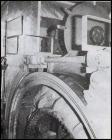1
Several different mining methods were used during a half century of mining at St. Lawrence. Simple trenching and benching of fluorspar veins exposed on the surface were the first methods used. The result was low productivity and bad working conditions because miners were exposed to all weather conditions. By 1939, the emphasis had moved to underground work. Mining fluorspar became more complex. Mines such as Black Duck and Iron Springs required vertical shafts for hoisting products and servicing underground workings. Drifts, crosscuts and raises had to be driven in order to bring the ore bodies into production.The most frequently used mining method during the early years of underground mining at St. Lawrence was shrinkage stoping. This is an overhand or back stoping method in which a major portion of the broken ore accumulates in the stopes and helps to support the walls. At St. Lawrence, closely spaced wall-to-wall timbers were used for additional support.
During the final years of mining, the methods changed to a combination of cut-and-fill and square-set-and-fill stoping. This method required the filling of the stopes with sand and tailings as the mining progressed. Square-set interlocking timbers combined with back-filling were used in the Director mine where the hanging walls and footwalls lacked competency. It is a labour-intensive, low production method.
ALCAN terminated mining at St. Lawrence in early November, 1977 and laid off its remaining staff on February 1, 1978.
2
Hoistman Robert Harris is operating the hoist at Director Mine1933-1978
St. Lawrence, Newfoundland and Labrador, Canada

